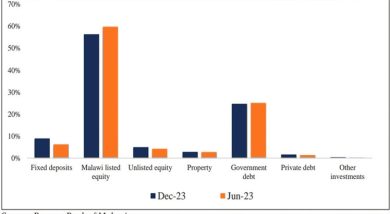Exports jump 6% in 20 years—report
Malawi’s exports grew at an average six percent between 1998 and 2018, against a growth rate of 10 percent in imports, figures show.
The disparity in the value of exports and imports exposes Malawi’s inability to narrow the gap between imports and exports in the past two decades despite relentless efforts by authorities to grow the export base.
The situation, according to trade experts, has exposed the country’s failure to achieve import substitution, a trade and economic policy which entails replacing foreign imports with domestic production.

A final draft review report for Vision 2020 compiled by Premier Consult Limited shows that over the past two decades, Malawi has been unable to transform from an importing and consuming nation to a producing and exporting one.
In 1998, Malawi developed Vision 2020, which was launched in 2000 as the country’s first long-term national development plan.
However, contrary to the aspiration of the blueprint to turn Malawi into a net exporter, the review has revealed that trade balance has deteriorated from $84 million to $1.8 billion (K1.3 trillion) during the Vision 2020 implementation era.
“Between 1998 and 2018, exports grew at the rate of six percent from $431 million [K318 billion] to $1 billion [K740 billion] while imports increased at the rate of 10 percent from $515 million [K381 billion] to $2.8 billion. Malawi’s trade balance deteriorated from $84 million [K62 billion] to $1.8 billion during the course of Vision 2020,” reads the report in part.
Based on the figures, Malawi’s trade gap at $1.8 billion [about K1.4 trillion] is equivalent to about 26 percent of the country’s total wealth as measured by gross domestic product (GDP) valued at $7 billion.
According to the report, the country’s exports have increasingly been unable to cover the growing import requirements.
“Hence, whereas in 1998, Malawi’s exports could support 86 percent of the nation’s import requirements by 2019, exports have generated foreign exchange enough to cover only 36 percent of import requirement,” reads the report.
For much of the Vision 2020 implementation period, the structure of exports has remained unchanged with traditional exports (tobacco, tea and sugar) dominating the export basket and averaging over 83 percent of the exports, it shows.
Ministry of Industry, Trade and Tourism Principal Secretary Ken Ndala admitted in an earlier interview that the first National Export Strategy (NES) was overdesigned and too ambitious to be realised within a five-year period “given the prevailing conditions”.
“Upon expiry of the strategy in 2018, exports as a share of imports were at 32.6 percent and the rate of growth of exports in value terms averaged 4.2 percent and this has been the case because of deficient resource mobilisation with heavy dependence on development partners and donor agencies,” he said.





